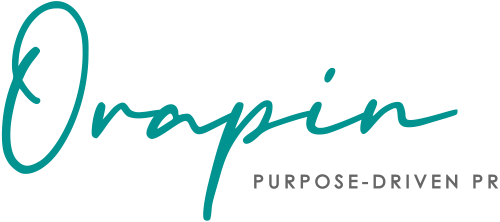
When it comes to PR planning, put your time toward the results that work best for you
As a marketer for a purpose-driven company or a non-profit organization, you may have limited resources – staff, time, and budget – to name a few. As such, ensuring that the resources you put toward PR activities are efficient and drive results is essential (no one wants to waste their time!). Here, we will explore which earned media strategies work best to achieve specific PR goals. Depending on your goals – for your organization, overall marketing plan, and PR efforts – some earned media strategies will undoubtedly have greater “bang for the buck.”
What is an earned media strategy?
We segment earned media into two main buckets – media relations and expert positioning. Media relations refers to pitching stories and securing media coverage for or as a result. Expert positioning refers to pitching an organization’s executive or executive team’s thought leadership or unique point of view. Conversely, owned media refers to the content you produce and self-publish on your social media channels, newsletter, blog, etc.
Below are several of the most commonly used PR tactics to support your earned media strategy and the benefits and potential shortcomings of each. Each tactic holds value in its own right, and if we had unlimited time and resources, we would say you should do them all! Knowing that this scenario is most likely not a reality for most organizations, take note of which tactics will best support your specific earned media goals and objectives.
The pros and cons of media relations tactics
1. Proactive media pitching
What it is: Proactive media pitching is when you pitch targeted media outlets to increase awareness of your organization and your mission, work, and impact. Proactive media pitching can include pitching timely and relevant stories as well as evergreen story ideas.
What it’s best for:
- Creating relationships with reporters
- Yielding future media coverage
- Ensuring you build and maintain consistent media buzz for your organization’s news and stories of impact
- Storytelling and creating organizational awareness and affinity
- Yielding impactful results with less time commitment required than other tactics
- Stories that are a good fit for very targeted reporters or media outlets
Where it falls short:
- Requires many timely, relevant stories to pitch
- Requires interest and availability of leadership to conduct interviews
- No control over how the media chooses to write the story
2. Reactive media pitching
What it is: Reactive media pitching is when you monitor headlines and buzz for news/stories about your industry and pitch relevant stories to piggyback on or your executives or subject matter experts to comment/speak to/provide quotes or op-eds in response to stories of national or local interest.
What it’s best for:
- When you have a story that’s a natural follow-up or expansion of the original story
- When your executive or expert has a unique point of view that can shed light on a topic or provide new insight and information for a story
- Supporting your organization or executive’s expertise or work in a subject area or field
- Providing localized insight into a story of national significance
Where it falls short:
- Requires quick turnaround time, responses to stories need to happen within the same news cycle and should be pitched within hours of when the original story
- Requires a unique point of view or information that adds to the dialogue as opposed to adding to the noise
3. Writing and sending press releases
What it is: A press release is a formal announcement to share key announcements, milestones, significant awards, new partnerships, or success stories with local and national media
What it’s best for:
- The moments that you have “big news” to share with a wide audience
- When you have a lot of detail to share for a specific news item, for example, a new product or service initiative, and want to explain and control the message fully
- Posting on a free or paid newswire provides a link to share on your owned media channels
Where it falls short:
- Press releases are likely to be ignored by the vast amount of media contacts who receive them
- Outlets may publish the press release in full as opposed to calling for an interview or doing a more in-depth story
The pros and cons of expert positioning tactics
1. Publishing byline articles
What it is: A byline article is a long-form article on a topic central to your organization’s work, area of expertise, or timely subject that builds credibility for the organization’s executives and experts among key audiences.
What it works best for:
- Reaching new audiences who may not know of your organization, who your leadership is, or the impact you are making in your field
- Showcasing the expertise, perspectives, and opinions of organizational leadership
- Maintaining full control over the message
- Creating opportunities for in-depth storytelling
- SEO gains as a result of backlinks to your website
Where it falls short:
- Requires a commitment of time and energy from both the comms team and executive leadership to draft and pitch articles
- Articles must be informational and insightful as opposed to sales-focused or promotional
2. Speaking at relevant events, conferences, etc.
What it is: Speaking engagements allow leaders to share their expertise on a specific topic with a targeted audience. Speaking engagements can run the gamut from keynote addresses at large national conferences to industry panel discussions, local business association luncheons, meet-and-greets, etc.
What it’s best for:
- Building rapport and awareness for an executive and their expertise or thought leadership on a specific topic
- When your executive has a unique point or expertise in a specific topic area and sharing that POV will support your organizational goals
- Controlling the message and providing a deep dive into your organization’s work
- Yielding future press or interview opportunities
- Capturing content from the event can be repurposed on your owned channels
Where it falls short:
- Requires leaders to allocate time and resources to prepare their key messages or speech
- Requires leaders to feel comfortable with public speaking and have excellent stage presence
- Can be costly due to associated travel expenses
3. Podcast interviews
What it is: Pitching and securing“special guest” appearances on podcasts that reach new and/or existing audiences who may be interested in your organization, your thought leadership, or your impact on the community. Podcasts can be industry-focused or general interest, depending on your organization, work, or message.
What it’s best for:
- Reaching new and/or niche audiences
- Providing a platform for a deep-dive interview with your CEO or subject matter expert
- Providing the opportunity to share expert opinion, information, or new points of view on a specific topic
- A third-party endorsement that your opinion and is worth listening to
Where it falls short:
- Requires leaders to allocate time and resources to prep for and participate in long-format interviews
4. Awards
What it is: Awards are a pat on the back for a job well done, but they also lend many opportunities for publicity and help build credibility.
What it’s best for:
- A third-party endorsement that your work or executive is worth paying attention to
- Creating opportunities for publicity
- Building organizational credibility amongst peers and partners in your industry or the greater business community
Where it falls short:
- Often requires lengthy applications with narratives and supporting metrics
- Often requires applying several years in a row to secure the win
- Awards can come with hefty application fees
How do you choose the PR tactics that are right for your organization?
Each tactic for media relations and expert positioning can yield fantastic results and PR goals. When deciding how to prioritize your efforts, you need to look at which tactics are realistic with your available resources and the interest level of your leaders and experts.
The common factor across all the tactics is some level of participation from your executive or spokesperson. All executives are busy, so where do they want to spend their time? What do they enjoy? Do they like public speaking? Is being on camera their jam? Would they much prefer to draft a long-form editorial piece? Or do they really not have time to do much of anything and need to say no to opportunities?
Focusing on tactics that will appeal to the availability and interest of your leaders will be one of the most critical aspects of your PR success. Prioritizing those tactics based on your team’s available resources will determine how well you reach and surpass your PR goals. Though we’d all love to “do it all,” picking tactics with these simple guidelines in mind will ensure you see greater success in your PR efforts.

Rhiannon Hendrickson is the founder and CEO of Orapin, which helps purpose-driven organizations transform their random acts of PR into a strategic, consistent approach that generates greater awareness and impact. She has worked with organizations of all sizes across myriad industries and causes to develop earned media and thought leadership programs that generate awareness, engagement, and, ultimately, support for those that are making a meaningful impact.
